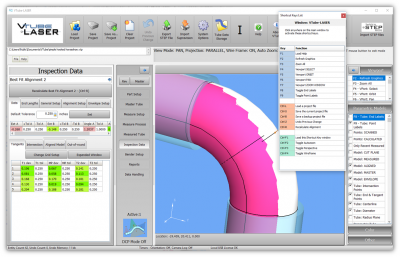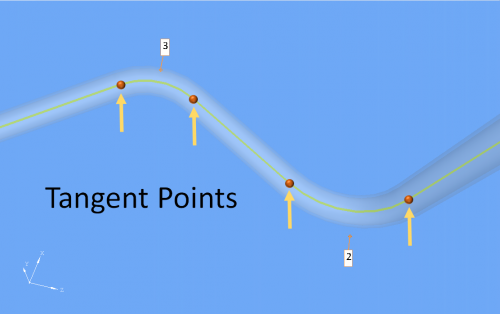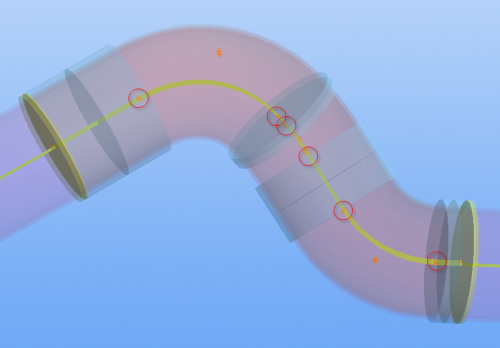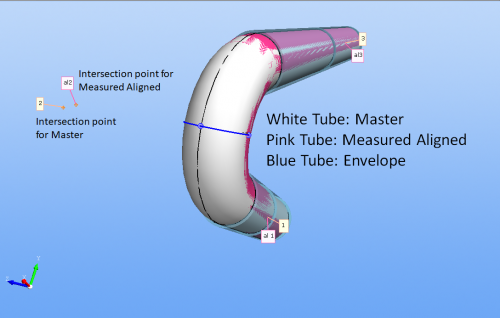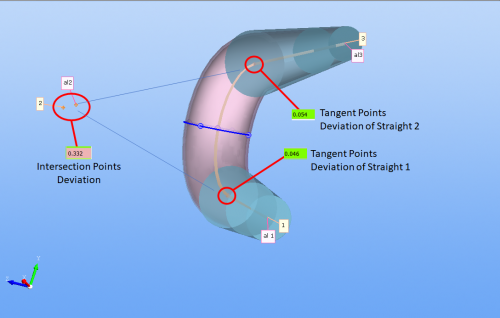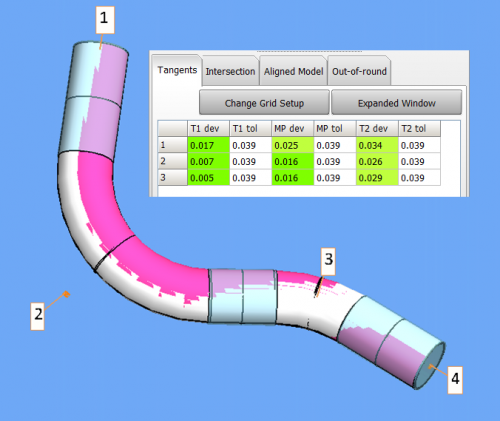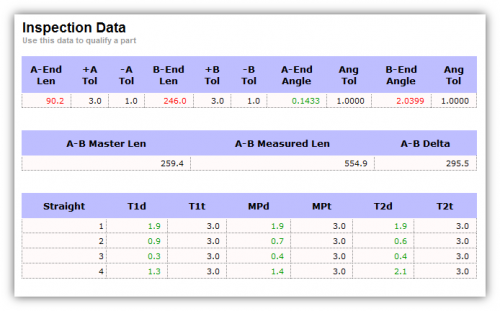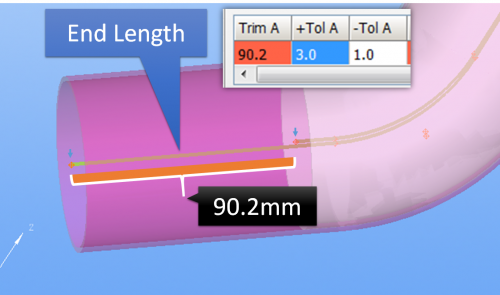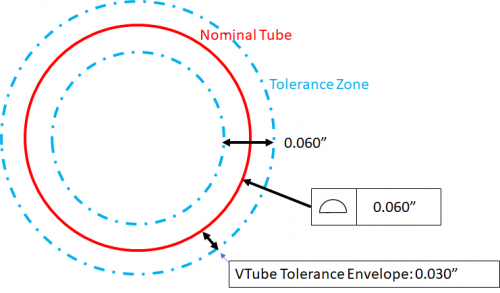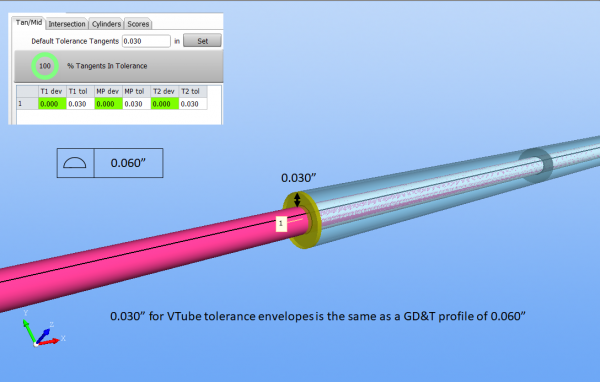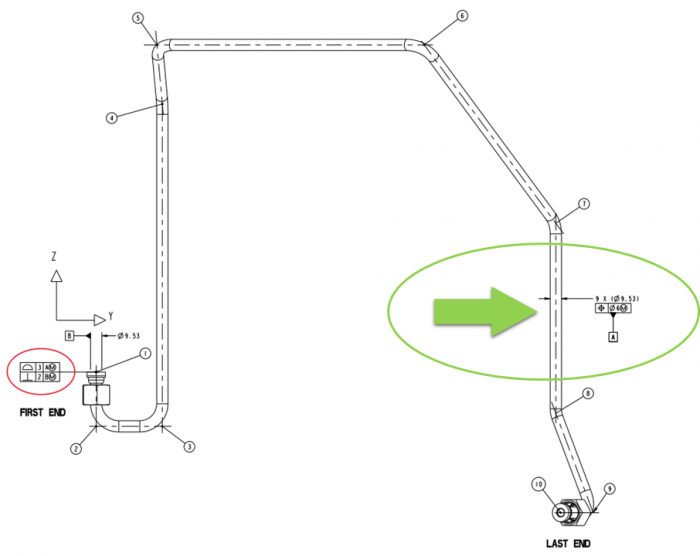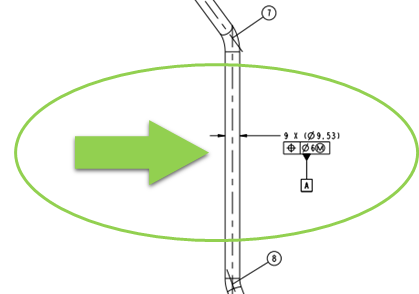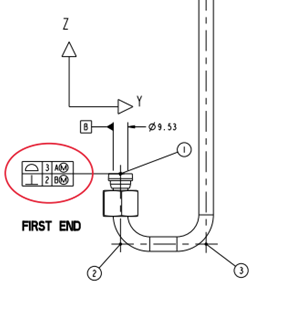What are Centerline Tangent Points and Why Are They Important in VTube-LASER?
Why are Tangent Points Important in Qualifying Tube Shapes?
|
Centerline tangent point deviations are important because they represent the best set of points along the centerline to qualify the shape of a tube. |
COMPARE XYZ Tangent Point Deviations to XYZ Intersection Point DeviationsCenterline XYZ intersection points (not the same as centerline XYZ tangent points) are sometimes used for tube shape qualification. However, intersection points are not a good choice for tube-shape qualification because:
|
|
A Visual Example of the Problem With Using Intersection Points for QualificationSee these two images to help understand the problem with using intersection points for qualification. |
|
|
However, the intersection points are separated by 0.332 inches. |
Tangent Point Deviations in the Inspection Data Grid
|
The Tangent chart is represented by a grid of straights for each row with tangent points and midpoints for each straight:
Note that the two end points are also included in the tangent charts are reports (T1d in straight 1, and T2d in the last straight). They are an exception to the technical tangent definition given above because there is no bend attached to these points. But these points still have value in determining if the part is the correct shape, so it is convenient to include them in this chart and grid - even though they are not really tangents. Midpoint deviations are always less than the highest corresponding tangent deviation, and higher than the lowest corresponding tangent deviation. They are included in traditional reports so that you can have three separate deviation tolerances in a straight. (T1-MP-T2)
|
The Same Data In Reports
|
The same tangent data can be shown in the reports like this. |
How to Understand the Tangent Data
About End Point Deviations
Automatic Internal Trimming of End Points for Shape
|
Even though the end points are not tangents, we can still use them in the chart because they qualify the part the same way that tangent points do. |
Untrimmed End Points for Lengths
|
However, the end length is 90.2mm too long. In this application, the customer bent the part 90mm too long on purpose in order to give the bend arm clamp die enough material on the first straight to grip. Notice that, even though the part is significantly too long, the BEST FIT algorithm didn't use the actual measured end point in the alignment. The alignment was based on the trimmed point on the measured centerline that was nearest the master end point. So, in this case the part shape in space is qualified - but it needs trimming by 90.2mm to also qualify the end length (another critical qualifier). |
Typical Industry Tangent Point Envelope Tolerances
|
In working with thousands of customers over the past few decades, we've seen some trends in accepted envelope deviation tolerances. Here are what we commonly see: Aerospace and Automative Fluid Lines
Automotive Exhaust Pipes
Automotive Fluid Lines
Shipbuilding
HVAC
Structural Tubes (Frames)
|
GD&T and VTube-LASER Tolerance Envelopes
|
GD&T tube profile tolerances are always double the VTube-LASER envelope tolerances. So, a GD&T profile tolerance of 3 mm is VTube-LASER's 1.5 mm envelope tolerance. All tolerances that we show below are half the GD&T profile tolerances. |
|
|
See this end profile image to visualize why GD&T profiles are double the VTube-LASER tolerance envelope. |
|
|
This image shows a tube with a 0.060" diameter with a 0.030" envelope in order to visualize the scale of the envelope in VTube. |
GD&T Feature Control Frame Examples
|
This is an actual example from a real print that was shared with us from a Fortune 500 company. This method of specifying tube shape tolerances is becoming the standard in every industry. |
|
|
Read the GD&T feature control frame for the tube shape like this:
|
|
|
Read the GD&T feature control frame at the end component of the tube is understood like this:
|
Other Pages
- About VTube-LASER End Point Deviations
- What are Centerline Tangent Points and Why Are They Important in VTube-LASER?
- About VTube Intersection Point Tolerances
- About VTube End Length Offsets
- Back to VTube-LASER

